

Custom Search
|
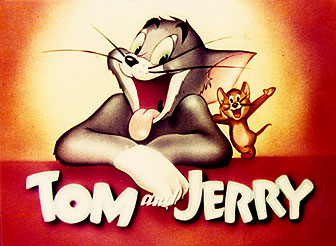 Tom & Jerry title card from the 1940s
Tom & Jerry title card from the 1940s
Tom and Jerry were an animated cat (Tom) and mouse (Jerry) team who formed the basis of a massively successful series of theatrical short cartoons created, written, and directed by animators William Hanna and Joseph Barbera (later of Hanna-Barbera fame), and produced by Metro-Goldwyn Mayer from 1940 to 1958. MGM later had more Tom & Jerry cartoons produced by outside studios in the 1960s (Gene Deitch's Rembrandt Films from 1961 to 1962, and Chuck Jones' Sib Tower 12 Productions from 1963 to 1967). Tom and Jerry later resurfaced in TV cartoons produced by Hanna-Barbera Productions (1975-1977; 1990-1993) and Filmation Studios (1980 - 1982). The original Hanna and Barbera shorts are notable for having won seven Academy Awards, tying it with Walt Disney's Silly Symphonies as the most-awarded theatrical cartoon series.
The plots of each short usually center on Tom's frustrated attempts to catch Jerry, and the mayhem and destruction that ensues. Because they seem to get along in some cartoon shorts (at least in the first minute or so), it is unclear why Tom chases Jerry so much, but some reasons given may include:
However, Tom usually never succeeds in defeating Jerry, mainly because of Jerry's own craftiness and cunning, but sometimes because of Tom's own stupidity. The shorts are famous for using some of the most destructive and violent gags ever devised for theatrical animation: Jerry slicing Tom in half, Tom using everything from axes, pistols, rifles, dynamite, and poison to try and murder Jerry, Jerry stuffing Tom's tail in a waffle iron, and so on. The Simpsons's cartoon-within-a-cartoon , Itchy and Scratchy, mercilessly parodies the violence of Tom and Jerry by featuring even more extreme violence.
Neither Tom nor Jerry usually speak in the cartoons. There are brief exceptions, but their vocals are generally restricted to screams of pain (almost entirely from Tom), or nervous gulps. Facial expressions and gestures easily convey the characters' feelings and intentions. Tom occasionally displays a surprising singing ability, usually to attract a lady friend. This is excusable as it generally copies a famous crooner, and is perhaps a reference of cats yowling during the night.
Music plays a very important part in the shorts, emphasising the action and lending appropriate emotion to the scenes. Musical director Scott Bradley created complex scores that combined elements of jazz, classical, and pop music; Bradley often reprised actual contemporary pop songs, as well as songs from MGM films such as The Wizard of Oz and Meet Me In St. Louis.
Before 1953, all Tom and Jerry cartoons were produced in the standard Academy ratio and format; from 1953 to 1956 some of the output was dually produced in both Academy format and the widescreen CinemaScope process. From 1956 until the close of the MGM animation studio a year later, all Tom and Jerry cartoons were produced in CinemaScope; some even had their soundtracks recorded in stereo. The 1960s Gene Deitch and Chuck Jones shorts were all produced in Academy format, but with compositions that made them compatible to be matted to Academy widescreen format as well. All of the Hanna and Barbera cartoons were produced in three-strip Technicolor; the 1960s entries were done in Metrocolor.
Tom is a bluish-grey housecat (or greyish-blue, depending on the short. His fur color is close to that of the Russian Blue breed of cats) who lives a pampered life, while Jerry is a small brown mouse who always lives in close proximity to him. Tom is very quick-tempered and thin-skinned, while Jerry is independent and opportunistic. Though very energetic and determined, Tom is no match for Jerry's brains and wits. By the iris-out of each cartoon, Jerry is usually left in a triumphant situation and Tom in a bad one. However, many other results have been reached: on rare occasions, Tom triumphs. Sometimes, usually ironically, they both lose. Once in a while, particularly at Christmas, Tom may actually save Jerry's life, or at least share gifts with him.
Both characters display sadistic tendencies, in that they are equally likely to take pleasure in tormenting each other. However, unlike Jerry, Tom has an enormously powerful conscience, and often panics if he thinks that Jerry is seriously injured, dying or dead. Jerry sometimes uses this to his advantage.
Although many supporting and minor characters speak, Tom and Jerry rarely do so. Tom, most famously, sings while wooing female cats; for example, he lip-syncs Louis Jordan's Is You Is Or Is You Ain't My Baby in the 1946 short Solid Serenade. His most noted spoken line occurs in three different shorts where Tom clearly says in an eerie, echoing voice don't you believe it . Co-director William Hanna provides most of the squeaks, gasps, and other vocal effects for the pair, including the most famous sound effect from the series, Tom's leather-lunged scream (created by recording Hanna's scream and chopping the head and tail off of the recording, leaving only the strongest part of the scream on the soundtrack).
In his attempts to catch Jerry, Tom often has to deal with the intrusions of characters such as Butch, a scruffy black alley cat who also wants to catch and eat Jerry; Spike (sometimes billed as Killer or Butch), a vicious guard bulldog who tries to beat up the cat; and Mammy-Two-Shoes, Tom's African American owner (voiced by Lillian Randolph), who usually wallops the cat with a broom when he misbehaves.
In the late 1940s, Jerry adopted a little gray mouse foundling named Nibbles (also known as Tuffy). During the 1950s, Spike is shown to have a son of his own named Tyke, an addition that lead to both a slight softening of Spike's character and a short-lived spin-off theatrical series (Spike and Tyke). Tyke's appearance also gave Jerry one more weapon against Tom, as disturbing Tyke was sure to bring Spike's wrath down on the apparent culprit, usually Tom. Occasionally Spike spoke, so to speak, using a voice and expressions modelled after Jimmy Durante, as in Dat's my boy! . Another character in the series was Quackers the duckling, who was later adapted into Hanna-Barbera's character Yakky Doodle.
William Hanna and Joseph Barbera were both part of the Rudolf Ising unit at MGM's animation studio in late 1930s. Barbera, a storyman and character designer, was paired with Hanna, an experienced director, to start directing films for the Ising unit; the first of which was a cat-and-mouse cartoon called Puss Gets the Boot (completed in late 1939, and released to theatres on February 10, 1940), Puss Gets The Boot centers around Jasper, a gray tabby cat trying to catch Jinx, a cute little mouse, but without breaking anything; Jasper's owner Mammy has threatened to throw Jasper out ( O-U-W-T, out! ) if he breaks one more thing in the house. Naturally, Jinx uses this to his advantage, and begins tossing wine glasses, ceramic plates, tea pots, and any and everything fragile, so that Jasper will get thrown outside. Puss Gets The Boot was previewed and released without fanfare, and Hanna and Barbera went on to direct other (non-cat-and-mouse related) shorts; after all, said many of the MGM staffers, haven't there been enough cat-and-mouse cartoons already?
The pessimistic attitude towards Jasper and Jinx changed when the cartoon became a favorite with theatre owners and with the Academy of Motion Picture Arts and Sciences, which nominated the film for the Academy Award for Best Short Subject: Cartoons of 1941. Another competitor for the award was Tex Avery's Merrie Melodies cartoon A Wild Hare, which featured the first appearance of the mature form of Bugs Bunny. Both nominees lost to another MGM cartoon, Rudolph Ising's The Milky Way.
However producer Fred Quimby, who ran the MGM animation studio, quickly pulled Hanna and Barbera off of the other one-shot cartoons they were working on, and commissioned a series featuring the cat and mouse. Hanna and Barbera held an intra-studio contest to give the pair a new name; animator John Carr won with his suggestion of Tom and Jerry. The Tom and Jerry series went into production with The Midnight Snack in 1941, and Hanna and Barbera never helmed anything but the cat-and-mouse cartoons for the rest of their tenure at MGM.
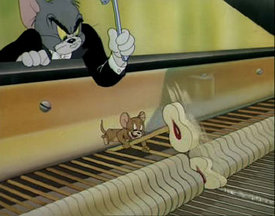 Tom & Jerry in the 1946 Academy Award winning cartoon The Cat Concerto
Tom & Jerry in the 1946 Academy Award winning cartoon The Cat Concerto
Tom's physical appearance evolved significantly over the years. During the early 1940s, Tom had an excess of detail--shaggy fur, numerous facial wrinkles, and multiple eyebrow markings--all of which were streamlined into a more workable form by the end of the 1940s; Jerry stayed essentially the same for the duration of the series. By the mid-1940s, the series had developed a quicker, more energetic (and violent) tone, thanks to inspiration from the work of MGM Animation colleague Tex Avery, who joined the studio in 1942.
Even though the basic theme of each short is virtually the same, Hanna and Barbera found endless variations on that theme. Barbera's storyboards and rough layouts and designs, combined with Hanna's timing, resulted in the most popular, successful, and highly acclaimed series the MGM animation department ever had. 13 entries in the Tom and Jerry series (excluding Puss Gets The Boot) were nominated for the Academy Award for Best Short Subject: Cartoons; seven of them went on to win the Academy Award, breaking the Disney studio's winning streak in that category. Tom and Jerry won more Academy Awards than any other character-based theatrical animated series.
Tom and Jerry remained popular throughout their original theatrical run, even when the budgets began to tighten a little in the 1950s and the pace of the shorts slowed slightly. However, after television became popular in the 1950s, box office revenues decreased for theatrical films, and short subjects. At first, MGM combated this by going to all-CinemaScope production on the series; but after the MGM accountants realized that their re-releases of the older shorts brought in just as much revenue as the new films, the studio executives decided, much to the surprise of the staff, to close the animation studio. The MGM animation department was shut down in 1957, and the final of the 114 Hanna and Barbera Tom and Jerry shorts, Tot Watchers, was released on August 1, 1958. Hanna and Barbera started their own television animation studio, Hanna-Barbera Productions, in 1957, which went on to produce such popular shows as The Flintstones, The Jetsons, and Scooby-Doo.
In 1960, MGM decided that they wanted to produce new Tom and Jerry shorts again, and had producer William Snyder make an arrangement with Czech animation director Gene Deitch and Deitch's studio, Rembrandt Films, to make the films overseas in Prague, Czechoslovakia. The Deitch/Snyder team turned out 13 shorts: Switchin' Kitten, Down and Outing, and It's Greek to Me-ow! in 1961 and The Tom and Jerry Cartoon Kit, Tall in the Trap, Sorry Safari, Mouse Into Space, Landing Stripling, High Steaks, Dicky Moe, Buddies Thicker Than Water, Carmen Get It! and Calypso Cat in 1962. The Deitch shorts are considered by some as being the worst of the Tom and Jerry theatrical shorts, although others have an affinity for their surreal qualities.
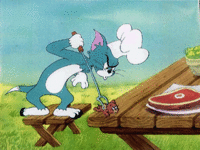 High Steaks, a 1961 Tom & Jerry short directed by Gene Deitch
High Steaks, a 1961 Tom & Jerry short directed by Gene Deitch
Since the Deitch/Snyder team only saw a handful of the original Tom and Jerry shorts, the films that resulted from the arrangement were considered unusual and, in many ways, bizarre. The characters' gestures were often performed at high speed, often resulting in heavy motion blur. The soundtracks featured sparse music, spacey sound effects, dialogue that was mumbled rather than spoken, and featured heavy uses of reverb.
Also notable is the fact that these shorts are the only Tom and Jerry cartoons not to carry the phrase Made In Hollywood, U.S.A. at the end. Due to Deitch's studio being behind the Iron Curtain, the production studio's location is omitted entirely.
Deitch's own story of his work on Tom and Jerry can be found at his personal website.
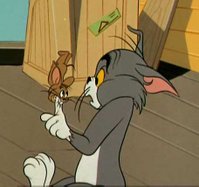 Cannery Rodent, one of the Tom & Jerry shorts directed by Chuck Jones
Cannery Rodent, one of the Tom & Jerry shorts directed by Chuck Jones
After the last of the Deitch cartoons were released, MGM turned to American director Chuck Jones, who had just ended his thirty-plus year tenure at the Warner Bros. Animation Department and started his own animation studio, Sib Tower 12 Productions, with partner Les Goldman. Jones and Goldman went on to produce 34 more Tom and Jerry shorts starting in 1963, all of which carried Jones' distinctive style (and a slight psychedelic influence), but with varying degrees of critical success. Jones co-directed the majority of the shorts with Maurice Noble; the remaining shorts were directed by Abe Levitow and Ben Washam, with Tom Ray directing two clip shows built around footage from the Hanna/Barbera era. MGM ceased production of animated shorts in 1967, by which time Sib Tower 12 had become part of MGM, and Jones had already begun to move on to television specials and the feature film The Phantom Tollbooth.
Beginning in 1965, the Hanna and Barbera Tom and Jerry films began to appear on television in heavily edited form: the Jones team was required to take the shorts that featured Mammy, rotoscope her out, and replace her with a thin white woman. Lillian Randolph's original voice tracks were replaced with June Foray performing in an Irish accent. Much of the extreme violence in the cartoons was also edited out. Starting out on CBS' Saturday Morning schedule on September 25, 1965, Tom and Jerry moved to CBS Sundays two years later and remained there until September 17, 1972.
When shown on television in the United Kingdom (from the late 1960s, usually on the BBC) Tom and Jerry cartoons were not cut for violence and Mammy was retained. As well as having regular slots, Tom and Jerry served the BBC in another way. When faced with disruption to the schedules (such as those occurring when live broadcasts overrun), the BBC would invariably turn to Tom and Jerry to fill any gaps, confident that it would retain much of an audience that might otherwise channel hop.
In 1986, MGM was purchased by Ted Turner. Turner sold the company in 1988, but retained MGM's pre-1986 film library, thus Tom and Jerry became the property of Turner Entertainment (where the rights stand today via Warner Bros.), and have in subsequent years appeared on Turner-run stations, such as TBS, TNT, Cartoon Network, Boomerang, and Turner Classic Movies.
Like a number of other animated cartoons in the 1930s, 1940s and 1950s, Tom and Jerry was not considered politically correct in later years. Some cartoons featured either Tom or Jerry in blackface following an explosion, which were subsequently cut when shown on television, as well as other ethnic stereotypes that were made fun of, particularly the black maid, Mammy Two Shoes, whose distinctive voice was dubbed in most of the cartoons that she appeared in. In one case, the character was reanimated as a slim, young, white lady.
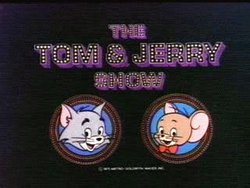 The title card for Hanna-Barbera's 1975 Tom and
Jerry Show
The title card for Hanna-Barbera's 1975 Tom and
Jerry Show
In 1975, Tom and Jerry were reunited with Hanna and Barbera, who produced new Tom and Jerry cartoons for Saturday morning. These 48 7-minute short cartoons were paired with Grape Ape and Mumbly cartoons, to create The New Tom & Jerry/Grape Ape Show, The Tom & Jerry/Grape Ape/Mumbly Show, and The Tom & Jerry/Mumbly Show, all of which ran on ABC Saturday Morning from September 6, 1975 to September 3, 1977. In these cartoons, Tom and Jerry (with red bow tie), who had been enemies during their formative years, became nonviolent pals who went on adventures together, as H-B had to meet the stringent rules against violence for children's TV.
In 1980, Filmation Studios (in association with MGM Television) also tried their hands at producing a Tom and Jerry TV cartoon series, this one called The Tom and Jerry Comedy Show and also featuring new cartoons starring MGM cartoon star Droopy, and supporting characters such as Spike and Barney Bear, not seen since the original MGM productions. Although they returned Tom and Jerry to the original chase formula, the Filmation cartoons were of noticeably lesser quality than Hanna-Barbera's efforts; this incarnation lasted on CBS Saturday Morning from September 6, 1980 to September 4, 1982.
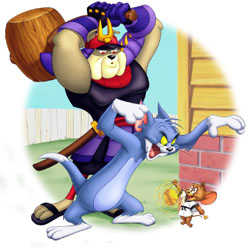 A promotional picture for the new Tom and Jerry cartoon that premiered January
2006
A promotional picture for the new Tom and Jerry cartoon that premiered January
2006
One of the biggest trends for Saturday morning television in the 1980s and 1990s was the babyfication of older, classic cartoon stars, and on September 8, 1990, Tom and Jerry Kids, produced by Hanna-Barbera Productions in association with Turner Entertainment, debuted on FOX, featuring a youthful version of the famous cat-and-mouse duo chasing each other. Spike and his son Tyke, and Droopy and his son Dripple, appeared in back-up segments for the show, which ran until October 2, 1993. This also marks the first appearance of the gameshow host Cabaloose Cal (voiced by Phil Hartman) and the laziest cat Clyde (voiced by Brian Cummings) and his assistant Kyle (voiced by Pat Fraley).
In 2000, a new Tom & Jerry cartoon entitled The Mansion Cat premiered on Cartoon Network. It featured Joseph Barbera as the voice of Tom's owner, whose face is never seen. In that cartoon, Jerry, housed in a habitrail, is as much of a house pet as Tom is, and their owner has to remind Tom to not blame everything on the mouse .
A new Tom & Jerry short, entitled The Karateguard, which had been directed and written by Joseph Barbera and produced by Spike Brandt and Tony Cervone premiered on Friday, January 27, 2006 at 9:00PM on Cartoon Network. A series of more new cartoons called Tom and Jerry Tales were produced at Warner Bros. in the first half of 2005. Thirteen half-hour episodes (each consisting of three shorts) were produced with only the 'foreign market' signed up. There was hope that they would air on the Cartoon Network, but no deal has yet been confirmed.
In 1945, Jerry made an appearance in the live-action MGM musical feature film Anchors Aweigh, in which, through the use of special effects, he performs a dance routine with Gene Kelly. In this sequence, Gene Kelly is telling a class of school kids a fictional tale of how he earned his medal of honor. Jerry is the king of a magical world populated with cartoon animals, whom he has forbidden to dance as he himself does not know how. Gene Kelly's character then comes along and guides Jerry through an elaborate dance routine, resulting in Jerry awarding him with a medal. Jerry speaks and sings in this film; his voice is performed by Sara Berner. Tom has a cameo in the sequence as one of Jerry's servants.
Both Tom and Jerry appear with Esther Williams in a dream sequence in another MGM musical, Dangerous When Wet (1953). In the film, Tom and Jerry are chasing each other underwater, when they run into Esther Williams, with whom they do an extended synchronized swimming routine. Tom and Jerry have to save Esther from a lecherous octopus, who tries to lure and woo Esther into his (many) arms.
1992 saw the overseas release of Tom and Jerry: The Movie, produced by Film Roman, was released to United States theatres in 1993. A musical in the typical Disney-esque vein, Tom and Jerry: The Movie was criticized by reviewers and audiences alike for being unoriginal, predictable, and for giving Tom and Jerry dialogue (and songs) through the entire film. The movie did poor business in America. In 2001, Warner Bros. which had by then merged with Turner and assumed its properties, released the direct-to-video movie The Magic Ring, in which Tom covets a ring which grants mystical powers to the wearer, and has become accidently stuck on Jerry's head.
Tom and Jerry began appearing in comic books in 1942, as one of the features in Our Gang Comics. In 1949, with MGM's live-action Our Gang shorts long out of production, the series was renamed Tom and Jerry Comics. The pair continued to appear in various books for the rest of the 20th century.
The pair have also appeared in a number of video games as well, including:
Tom and Jerry for Nintendo Entertainment System
Tom and Jerry: The Movie for Sega Game Gear
Tom and Jerry for Super Nintendo & Sega Genesis
Tom and Jerry: Mouse Attacks for Game Boy Color
Tom and Jerry: Infurnal Escape for the Game Boy Advance
Tom and Jerry: The Magic Ring for the Game Boy Advance
Tom and Jerry: War of the Whiskers for the PlayStation 2, Xbox, and Nintendo
GameCube
Tom and Jerry: House Trap for the PlayStation
Tom and Jerry: Fists of Furry for Nintendo 64 and PC
Due to its lack of dialog, Tom and Jerry has been translated into numerous foreign languages.
Tom and Jerry began broadcast in Japan in 1964. A 2005 nationwide survey taken in Japan by TV Asashi, sampling age groups from teenagers to adults in their sixties, in 2005 ranked Tom and Jerry #85 in a list of the top 100 anime of all time, while their web poll taken after the airing of the list ranked it at #58. [1] Tom and Jerry is also well-known in China.
Tom and Jerry have long been popular in Germany. However, the cartoons are overdubbed with rhyming German-language verse that describes what is happening onscreen.
The following cartoons won the Academy Award for Best Short Subject: Cartoons:
1943: The Yankee Doodle Mouse
1944: Mouse Trouble
1945: Quiet, Please!
1946: The Cat Concerto
1948: The Little Orphan
1952: The Two Mouseketeers
1953: Johann Mouse see (Johann Strauss II)
These cartoons were nominated for the Academy Award for Best Short Subject: Cartoons, but did not win:
1940: Puss Gets the Boot (Jasper and Jinx)
1941: The Night Before Christmas
1947: Dr. Jekyll and Mr. Mouse
1949: Hatch Up Your Troubles
1951: Jerry's Cousin
1954: Touch, Pussy Cat!
Tom and Jerry, animated cat, Tom, mouse, Jerry, theatrical, short cartoons, created, written, directed, animators, William Hanna, Joseph Barbera, Metro-Goldwyn